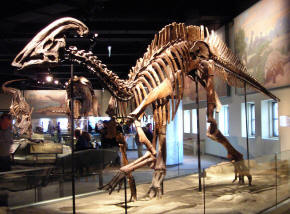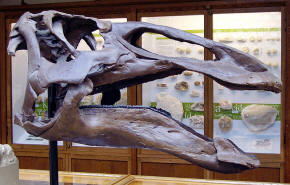to that of modern
ducks. In some
genera, most notably Anatotitan, the whole front of the skull was flat and broadened out
to form a beak, ideal for clipping leaves and twigs from the
forests of
Asia, Europe and North America. However, the back of the mouth contained
literally thousands of teeth suitable for grinding food before it was
swallowed. This has been hypothesized to have been a crucial factor in the
success of this group in the Cretaceous, compared to the
sauropods which were still largely dependent on
gastroliths for grinding their food.
In 2009, paleontologist
Mark Purnell conducted a
study into the chewing methods and diet of hadrosaurids. By analyzing hundreds of microscopic scratches
on the teeth of a fossilized
Edmontosaurus jaw, the team determined hadrosaurs had a unique way
of eating unlike any creature living today. In contrast to a flexible lower
jaw joint prevalent in today's mammals, hadrosaurs had a unique hinge
between the upper jaws and the rest of its skull. The team found the
dinosaur's upper jaws pushed outwards and sideways while chewing, as the
lower jaw slid against the upper teeth.
Discoveries
Hadrosaurids were the first dinosaur family to be identified in North
America, the first traces being found in 1855-1856 with the discovery of
fossil
teeth.
Joseph Leidy examined the teeth, and erected the
genera
Trachodon
and
Thespesius (others included
Troodon,
Deinodon
and
Palaeoscincus). One species was named
Trachodon mirabilis.
Now it seems that the teeth genus Trachodon is a mixture of all sorts
of cerapod dinosaurs, including
ceratopsids. In 1858 the teeth were associated with Leidy's eponymous
Hadrosaurus foulkii, named after the fossil hobbyist
William Parker Foulke. More and more teeth were found, resulting in even
more (now obsolete) genera.
A second duck-bill skeleton was unearthed, and was named
Diclonius
mirabilis in 1883 by
Edward Drinker Cope, which he incorrectly used in favor of
Trachodon
mirabilis. But Trachodon, together with other poorly typed
genera, was used more widely and, when Cope's famous "Diclonius mirabilis"
skeleton was mounted at the
American Museum of Natural History, it was labeled as "Trachodont
dinosaur". The duck-billed dinosaur family was then named Trachodontidae.
A very well-preserved complete hadrosaurid specimen (Edmontosaurus
annectens) was recovered in 1908 by the fossil collector
Charles Hazelius Sternberg and his three sons, in
Converse County, Wyoming. Analyzed by
Henry Osborn in 1912, it has come to be known as the "Trachodon
mummy". This specimen's skin was almost completely preserved in the form
of impressions.
Lawrence Lambe erected the genus
Edmontosaurus ("lizard from
Edmonton") in 1917 from a find in the lower Edmonton Formation (now
Horseshoe Canyon Formation),
Alberta.
Hadrosaurid systematics were addressed in a 1942
monograph
by
Richard Swann Lull and
Nelda Wright. They proposed the genus
Anatosaurus for several species of dubious genera. Cope's famous
mount at the AMNH became Anatosaurus copei. In 1990,
Anatosaurus
was moved to Edmontosaurus. One former
Anatosaurus species was
distinct enough from Edmontosaurus to be placed in a separate genus,
named
Anatotitan, so in 1990 the AMNH mount was re-labelled
Anatotitan
copei.
Hadrosaurid remains have been found in rocks above the
K-T boundary, indicating that some dinosaurs lived on for up to 400,000
years after most dinosaurs became extinct.
One of the most complete fossilized specimens was found in 1999 in
Hell Creek Formation of North Dakota and now is nicknamed "Dakota".
The hadrosaur fossil is so well preserved that scientists have been able to
calculate its muscle mass and learn that it was more muscular than thought,
probably giving it the ability to outrun predators such as
Tyrannosaurus rex. Unlike the collections of bones found in museums,
this mummified hadrosaur fossil comes complete with skin (not merely skin
impressions), ligaments, tendons and possibly some internal organs. It is
being analyzed in the world's largest
CT scanner, operated by the
Boeing Company.
The machine usually is used for detecting flaws in space shuttle engines and
other large objects, but previously none as large as this. Researchers hope
the technology will help them learn more about the fossilized insides of the
creature. They also found a gap of about a centimeter between each vertebra,
indicating that there may have been a disk or other material between them,
allowing more flexibility and meaning the animal was actually longer than
what is shown in a museum.
Classification
The family Hadrosauridae was first used by
Edward Drinker Cope in 1869. Since its creation, a major division has
been recognized in the group, between the (generally crested) subfamily
Lambeosaurinae and (generally crestless) subfamily
Saurolophinae (or Hadrosaurinae).
Phylogenetic analysis has increased the resolution of hadrosaurid
relationships considerably. For more on this topic, please see the
Wikipedia page for Hadrosaurid.
Paleobiology
Diet
While
studying into the chewing methods of hadrosaurids in 2009, the
paleontologists Vincent Williams, Paul Barrett, and
Mark Purnell found that hadrosaurs likely grazed on horsetails and
vegetation close to the ground, rather than browsing higher-growing leaves
and twigs. This conclusion was based upon the evenness of scratches on
hadrosaur teeth, which suggested the hadrosaur used the same series of jaw
motions over and over again.
As a result, the study determined that the hadrosaur diet was probably made
of leaves and lacked the bulkier items such as twigs or stems, which might
have required a different chewing method and created different wear
patterns.
However, Purnell said these conclusions were less secure than the more
conclusive evidence regarding the motion of teeth while chewing.
The hypothesis that hadrosaurs were likely grazers rather than browsers
appears to contradict previous findings from preserved stomach contents
found in the fossilized guts in previous hadrosaurs studies.
The most recent such finding before the publication of the Purnell study was
conducted in 2008, when a team led by
University of Colorado at Boulder graduate student Justin S. Tweet found
a homogeneous accumulation of millimeter-scale leaf fragments in the gut
region of a well-preserved partially-grown
Brachylophosaurus.
As a result of that finding, Tweet concluded in September 2008 that the
animal was likely a browser, not a grazer.
In response to such findings, Purnell said preserved stomach contents are
questionable because they do not necessarily represent the usual diet of the
animal. The issue remains a subject of debate.
Coprolites (fossilized droppings) of some Late
Cretaceous hadrosaurs show that the animals sometimes deliberately ate
rotting wood. Wood itself is not nutritious, but decomposing wood would have
contained fungi, decomposed wood material and
detritus-eating
invertebrates, all of which would have been nutritious.
Reproduction
Baby-sized hadrosaur fossils have been documented in the
scientific literature.
Tiny hadrosaur footprints have been discovered in the
Blackhawk Formation of
Utah.
In the
Dinosaur Park Formation
In 2001
Darren H. Tanke and
M. K. Brett-Surman reviewed and described
eggshell
and hatchling material from the
Dinosaur Park Formation of
Dinosaur Provincial Park.
Eggshell is rare in the Park, being present in only two
microfossil sites, both of which are predominated by the preserved
shells of invertebrate life.
The survival of hadrosaur eggshell fragments in the presence of these
invertebrate shells may be result of
calcium
in the invertebrate shells buffering contemporary
acidic water which would have dissolved them.
The
hadrosaur eggshell fragments "show little to no stream abrasion"
suggesting that the material did not originate far from their final burial
place in the Park.
The authors felt that their newly reported material corroborated the
then-recent suggestion that hadrosaurs did not nest exclusively in upland
areas, but also areas of lower elevation.
Some recovered hadrosaur fossils might actually be from
embryos.
Hatchling and nestling-sized hadrosaur remains had been falsely considered
rare in
Dinosaur Park Formation due to bias on the part of collectors seeking
larger specimens and sometimes not recognizing what was encountered.
Hadrosaurs had been speculated to be upland breeders due to the lack of
preserved egg and hatchling material.
However young hadrosaur remains had been previously reported from lowland
deposits. Darren Tanke observed that an experienced collector could actually
discover multiple juvenile hadrosaur specimens a day.
During the
1992 field season a concerted effort was undertaken by the
Royal Tyrell Museum to recover the remains of young hadrosaurs.
The researchers describe the acquisition that season of 43 specimens as
being a success.
Most of the recovered fossils were of
dentaries missing their teeth, bones from limbs and feet, as well as
vertebral
centra.
The material showed little or none of the
abrasion
that would have resulted from transport, meaning the fossils were buried
near their point of origin.
The researchers conclude that this meant that hadrosaurs were nesting in the
lowlands of the area represented by the strata containing the fossils and
that previous workers hypotheses of lowland hadrosaur breeding were
"confirmed."
It was the slow dissolution of shells left by clams and snails releasing
calcium carbonate into the water that raised the water's
pH high enough to
prevent the eggshells from dissolving.
The no fragment's greatest dimension exceeds one cm.
The eggshells' surface has a pebbly texture.
Dinosaur Provincial Park eggshell is similar to the eggshells from the
Two Medicine and
Judith River Formations of Montana as well as eggshell from the
Devil's Coulee in southern
Alberta.
Most hadrosaur
neonate (baby) bones are incomplete due to their small size and vulnerability
to the high erosion rates in the Dinosaur Provincial Park.
Dentaries are common hadrosaur neonate fossils.
Most specimens don't preserve all of the tooth replacement gooves.
Most preserve only about ten tooth files.
No neural arches are represented among the vertebrae fossils.
Although some limb bones show signs of transport wear, the distances
traveled before burial were probably not far as such small bones would be
unlikely to survive the great diversity of scavengers and acidic water
conditions.
The breakdown of
tannins from
coniferous vegetation would have caused the pH of the waters in the park
to be acidic.
Dinosaur eggshell is lacking from the bone beds producing the hadrosaur
juvenile bones.
The authors concluded that hadrosaurs nested in both upland or lowland
area, although described factors influencing the division of breeding
locations as unknown.
They suggested that "diet, soil conditions, habits, [and] competition"
between dinosaur genera might have played roles.
Some of the less common hadrosaurs in the Dinosaur Park Formation of
Dinosaur Provincial Park like
Brachylophosaurus or
Parasaurolophus may have had a more upland habitat where they may
have nested or fed.
Development
The limbs of the juvenile hadrosaurs are anatomically and proportionally
similar to those of adult animals.
However, the joints often show "predepositional erosion or concave articular
surfaces."
Probably due to the cartilaginous cap covering the ends of the bones.
The pelvis of a young hadrosaur was similar to that of an older individual.
Daily activity
patterns
Comparisons between the
scleral rings of several hadrosaur genera (Corythosaurus,
Prosaurolophus, and
Saurolophus) and modern birds and reptiles suggest that they may
have been
cathemeral, active throughout the day at short intervals.
Return to the
Old Earth Ministries Online Dinosaur
Curriculum homepage.


